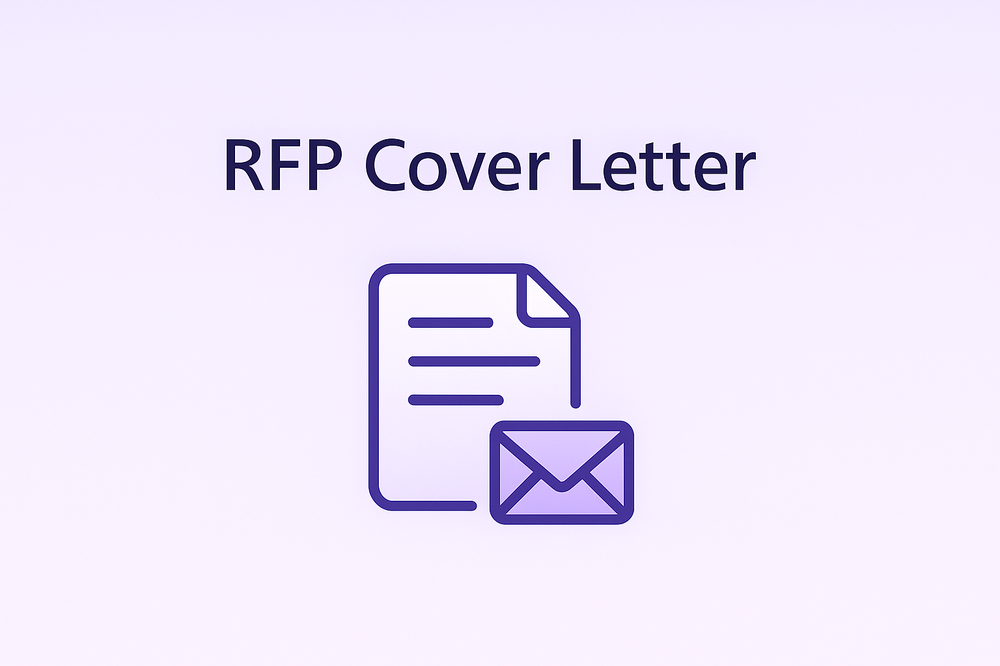RFP Cover Letter – Examples & Best Practices

What Is an RFP Cover Letter?
An RFP cover letter is a short, formal introduction that accompanies a Request for Proposal (RFP) response.
It provides context for your proposal, summarizes your company’s strengths, and sets the tone for how reviewers perceive your submission.
While the proposal dives into technical details and pricing, the cover letter acts as your first impression—a persuasive narrative that connects your solution to the buyer’s goals.
Want to learn how to write a strong one? Read our full guide: Essential Elements of an RFP Cover Letter.
Purpose of an RFP Cover Letter
An effective RFP cover letter:
- Introduces your company and explains your intent to bid.
- Summarizes key differentiators that set your solution apart.
- Acknowledges the client’s objectives and mirrors their priorities.
- Encourages engagement by inviting follow-up conversations or demos.
Think of it as the “executive summary” for your proposal—concise, confident, and client-focused.
Key Elements of a Strong RFP Cover Letter
- Personalized Greeting – Address the evaluator or procurement contact by name.
- Engaging Introduction – Mention the project or RFP title to immediately show relevance.
- Company Overview – Briefly describe your background and relevant experience.
- Alignment with Client Goals – Highlight how your offering meets their specific needs.
- Value Proposition – Emphasize results, ROI, or unique capabilities.
- Call to Action – End with contact details and an invitation to continue the conversation.
For examples and templates, visit Common Mistakes in RFP Cover Letters.
Why It Matters
A well-crafted RFP cover letter can be the difference between being shortlisted or overlooked. It shows:
- Professionalism: Attention to detail signals reliability.
- Understanding: Tailoring your message to the client’s pain points demonstrates preparation.
- Confidence: A strong tone builds trust before evaluators even open the full proposal.
Automation tools like Iris Pro can help teams generate and personalize RFP cover letters faster—integrating company data, tone, and compliance language automatically.
Best Practices
- Keep it under one page (250–350 words).
- Mirror the client’s tone and terminology from the RFP.
- Reference a specific challenge the client mentioned.
- Avoid generic phrases like “we are pleased to submit.”
- Always proofread for grammar, tone, and formatting consistency.
Explore more in our article: Common Mistakes in RFP Cover Letters.
Frequently Asked Questions: RFP Cover Letters
What’s the ideal length for an RFP cover letter?
An effective RFP cover letter should be concise—typically one page or about 250–350 words. The goal is to provide enough context to engage reviewers without repeating details found in the full proposal.
Should every RFP include a cover letter?
Yes. Even when not explicitly required, including a tailored cover letter sets a professional tone, reinforces your brand, and differentiates your submission from competitors who may skip it.
Who should sign the RFP cover letter?
Ideally, the letter should be signed by an executive or senior leader—someone who signals authority and accountability. For smaller teams, a director or project lead is also appropriate.
How can automation improve cover letter creation?
Automation tools like Iris Pro can generate personalized, compliant cover letters using pre-approved templates and company data—ensuring every submission aligns with brand tone and messaging while saving valuable time.
What’s the most common mistake teams make in RFP cover letters?
The most frequent issue is writing a generic introduction that could apply to any client. Successful letters focus on the buyer’s goals, use their terminology, and clearly connect your solution to their specific challenges.
Related Reading
- How to Write an Effective RFP Cover Letter
- Common Mistakes in RFP Cover Letters (and How to Avoid Them)
- RFP Response Templates and Best Practices
- What Is an RFP? A Complete Breakdown
- How to Structure an RFP Proposal
- RFP Automation: What It Is and Why It Matters
- RFI, RFQ, and RFP — What’s the Difference?
- Security Questionnaires Explained
- Due Diligence Questionnaires (DDQs): A Complete Overview
















